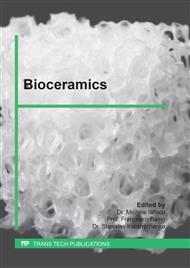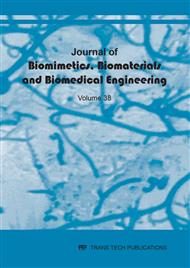[1]
Yuan-Chien Chen M-YS, Yuan-Haw Andrew Wu, Kai-Xing Alvin Lee, Li-Ju Wei, Yu-Fang Shen. Anti-inflammation performance of curcumin-loaded mesoporous calcium silicate cement. Journal of the Formosan Medical Association. 116(2017) 679-88.
DOI: 10.1016/j.jfma.2017.06.005
Google Scholar
[2]
Hao-Chieh Chang CY, Fang Feng, Feng-Huei Lin, Chi-Hwa Wang , Po-Chun Chang. Bone morphogenetic protein-2 loaded poly(D,L-lactide-co-glycolide) microspheres enhance osteogenic potential of gelatin/ hydroxyapatite/b-tricalcium phosphate cryogel composite for alveolar ridge augmentation. Journal of the Formosan Medical Association.116 (2017).
DOI: 10.1016/j.jfma.2017.01.005
Google Scholar
[3]
A. Boukhlif et al. Numerical Evaluation of Biomechanical Stresses in Dental Bridges Supported by Dental Implants. Journal of Biomimetics, Biomaterials and Biomedical Engineering. 37 (2018) 43-54.
DOI: 10.4028/www.scientific.net/jbbbe.37.43
Google Scholar
[4]
F. Qulub et al. Synthesis and Characterization of Composite Poly(1.8 Octanediol-co-Citrate) (POC)/Nano-Hydroxyapatite as Candidate Biodegradable Bone Screw. Journal of Biomimetics, Biomaterials and Biomedical Engineering. 27 (2016) 36-43.
DOI: 10.4028/www.scientific.net/jbbbe.27.36
Google Scholar
[5]
L. Grima et al. Preparation and Characterization of Novel Bioceramic Coatings on Ti6Al4V Substrates for Biomedical Applications. Key Engineering Materials. 758 (2017) 39-43.
DOI: 10.4028/www.scientific.net/kem.758.39
Google Scholar
[6]
Khan AF, Saleem M, Afzal A, Ali A, Khan A, Khan AR. Bioactive behavior of silicon substituted calcium phosphate based bioceramics for bone regeneration. Materials Science and Engineering: C. 35 (2014) 245-52.
DOI: 10.1016/j.msec.2013.11.013
Google Scholar
[7]
Pietak AM, Reid JW, Stott MJ, Sayer M. Silicon substitution in the calcium phosphate bioceramics. Biomaterials. 28 (2007) 4023-32.
DOI: 10.1016/j.biomaterials.2007.05.003
Google Scholar
[8]
Porter AE, Patel N, Skepper JN, Best SM, Bonfield W. Comparison of in vivo dissolution processes in hydroxyapatite and silicon-substituted hydroxyapatite bioceramics. Biomaterials. 24 (2003) 4609-20.
DOI: 10.1016/s0142-9612(03)00355-7
Google Scholar
[9]
Palard M, Combes J, Champion E, Foucaud S, Rattner A, Bernache-Assollant D. Effect of silicon content on the sintering and biological behaviour of Ca10(PO4)6-x(SiO4)x(OH)2-x ceramics. Acta Biomaterialia. 5 (2009) 1223-32.
DOI: 10.1016/j.actbio.2008.10.016
Google Scholar
[10]
Padilla S, Román J, Sánchez-Salcedo S, Vallet-Regí M. Hydroxyapatite/SiO2–CaO–P2O5 glass materials: In vitro bioactivity and biocompatibility. Acta Biomaterialia. 2 (2006) 331-42.
DOI: 10.1016/j.actbio.2006.01.006
Google Scholar
[11]
Martínez IM, Meseguer-Olmo L, Bernabeu-Esclapez A, Velásquez PA, De Aza PN. In vitro behavior of α-tricalcium phosphate doped with dicalcium silicate in the system Ca2SiO4–Ca3(PO4)2. Materials Characterization. 63 (2012) 47-55.
DOI: 10.1016/j.matchar.2011.10.013
Google Scholar
[12]
Martínez IM, Velásquez P, Meseguer-Olmo L, Bernabeu-Esclapez A, De Aza PN. Preparation and characterization of novel bioactive α-Tricalcium Phosphate doped with Dicalcium Silicate ceramics. Materials Science and Engineering: C. 32 (2012) 878-86.
DOI: 10.1016/j.msec.2012.02.006
Google Scholar
[13]
De Aza PN, García-Bernal D, Cragnolini F, Velasquez P, Meseguer-Olmo L. The effects of Ca2SiO4–Ca3(PO4)2 ceramics on adult human mesenchymal stem cell viability, adhesion, proliferation, differentiation and function. Materials Science and Engineering: C. 33 (2013).
DOI: 10.1016/j.msec.2013.05.043
Google Scholar
[14]
Gomes S, Renaudin G, Mesbah A, Jallot E, Bonhomme C, Babonneau F, et al. Thorough analysis of silicon substitution in biphasic calcium phosphate bioceramics: A multi-technique study. Acta Biomaterialia. 6 (2010) 3264-74.
DOI: 10.1016/j.actbio.2010.02.034
Google Scholar
[15]
Kao C-T, Huang T-H, Chen Y-J, Hung C, Jr., Lin C-C, Shie M-Y. Using calcium silicate to regulate the physicochemical and biological properties when using β-tricalcium phosphate as bone cement. Materials Science and Engineering: C. 43 (2014).
DOI: 10.1016/j.msec.2014.06.030
Google Scholar
[16]
Serena S, Caballero A, de Aza PN, Sainz MA. New evaluation of the in vitro response of silicocarnotite monophasic material. Ceramics International. 41 (2015) 9411-9.
DOI: 10.1016/j.ceramint.2015.03.319
Google Scholar
[17]
Bulina NV, Chaikina MV, Gerasimov KB, Ishchenko AV, Dudina DV. A novel approach to the synthesis of silicocarnotite. Materials Letters. 164 (2016) 255-9.
DOI: 10.1016/j.matlet.2015.10.047
Google Scholar
[18]
Palard M, Champion E, Foucaud S. Synthesis of silicated hydroxyapatite Ca10(PO4)6−x(SiO4)x(OH)2−x. Journal of Solid State Chemistry. 181 (2008) 1950-60.
DOI: 10.1016/j.jssc.2008.04.027
Google Scholar
[19]
Fix W, Heymann H, Heinke R. Subsolidus Relations in the System 2CaO·SiO2-3CaO·P2O5. Journal of the American Ceramic Society. 52 (1969) 346-7.
DOI: 10.1111/j.1151-2916.1969.tb11948.x
Google Scholar
[20]
A. Bouregba H. Ez-Zaki, A. Diouri, O. Sassi. β-Dicalcium Silicate Cement Modified with β-Tricalcium Phosphate: In Vitro Bioactivity and Mechanical Strength. Journal of Biomimetics, Biomaterials and Biomedical Engineering. 35 (2018) 9-19.
DOI: 10.4028/www.scientific.net/jbbbe.35.9
Google Scholar
[21]
A. Bouregba A. Diouri. Potential formation of hydroxyapatite in total blood and dicalcium silicate elaborated from shell and glass powders. Materials Letters. 183 (2016) 405–7.
DOI: 10.1016/j.matlet.2016.07.153
Google Scholar
[22]
Gal J-Y, Fovet Y, Adib-Yadzi M. About a synthetic saliva for in vitro studies. Talanta. 53 (2001) 1103-15.
DOI: 10.1016/s0039-9140(00)00618-4
Google Scholar
[23]
Deliormanlı AM. Investigation of in vitro mineralization of silicate-based 45S5 and 13-93 bioactive glasses in artificial saliva for dental applications. Ceramics International. 43 (2017) 3531-9.
DOI: 10.1016/j.ceramint.2016.11.078
Google Scholar
[24]
F.Triviňo FPa. Examinations by Infra-Red Spectroscopy for the polymorphs of dicalcium Silicate. Cement and Concrete Reserch. 15 (1985) 127-33.
DOI: 10.1016/0008-8846(85)90017-1
Google Scholar
[25]
Serena S, Sainz MA, Caballero A. Single-phase silicocarnotite synthesis in the subsystem Ca3(PO4)2–Ca2SiO4. Ceramics International. 40 (2014) 8245-52.
DOI: 10.1016/j.ceramint.2014.01.022
Google Scholar
[26]
Hench LL. Bioceramics. J Am Ceram Soc. 81 (1998) 1705–28.
Google Scholar



